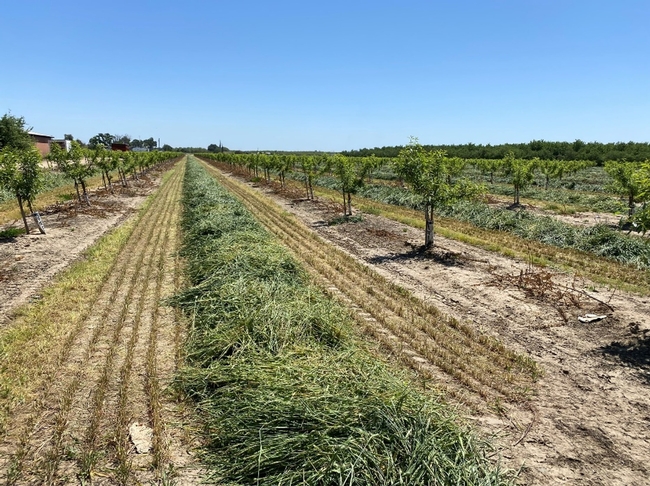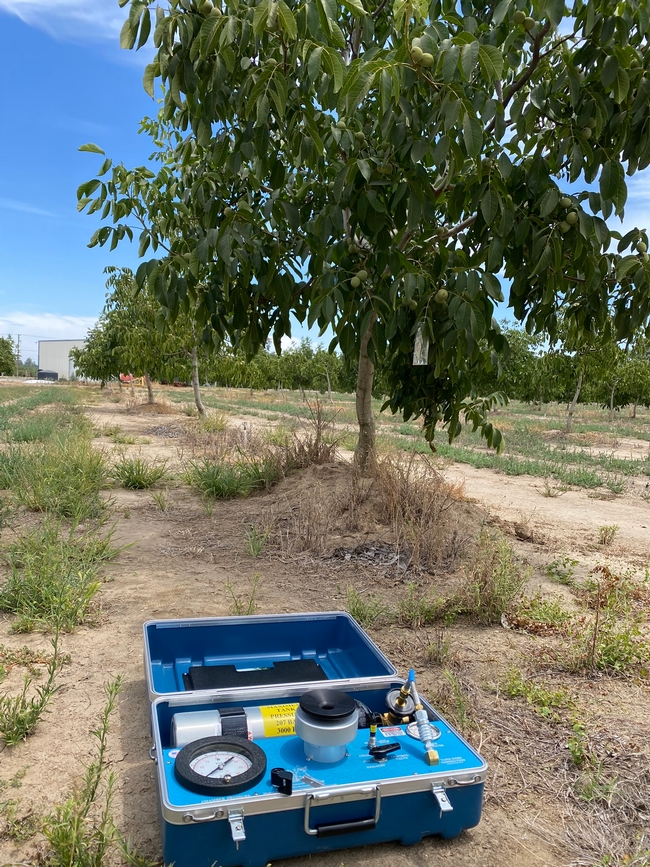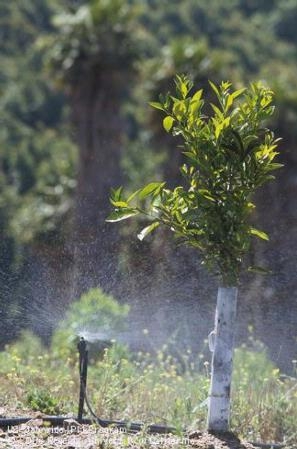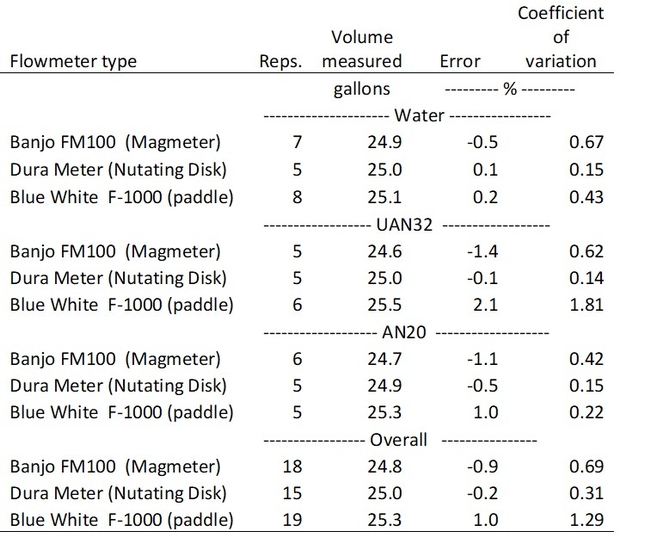Posts Tagged: fertilizer
Nutrient Strategies to Combat Branched Broomrape
Broomrapes (Orobanche and Phelipanche spp.) are obligate plant parasites with a broad range of agricultural crop hosts. In non-parasitic plant species, seeds generally initiate germination when exposed to favorable conditions of temperature, humidity,...
Young orchard water and nutrient management workshops offered in Modesto, Merced, Fresno, Bakersfield
Growers invited to discuss young almonds, pistachios, walnuts, olives and citrus orchards starting May 9
To help growers manage irrigation and nutrients for young and immature orchards, UC Cooperative Extension is offering workshops in Modesto, Merced, Fresno and Bakersfield.
The workshops will feature presentations by various experts and researchers focusing on best irrigation and nutrient management practices tailored specifically for young orchards in the San Joaquin Valley. They will cover almonds, pistachios, walnuts, olives and citrus.
“Attendees will gain insights into the irrigation and nutrient needs of young orchards, which are different from those applicable to mature orchards, and learn strategies for adjusting these practices as orchards mature,” said Moneim Mohamed, UC Cooperative Extension irrigation and soils advisor for Stanislaus, San Joaquin and Merced counties. “This knowledge aims to ensure healthier tree development, better resource use and more resilient orchards in the face of climate change.”
Growers, certified crop advisers and other agricultural professionals are encouraged to attend. Workshop attendees may request one-on-one assistance from a UCCE farm advisor.
Speakers include UCCE advisors Mohamed, Mae Culumber, Tobias Oker, and Cameron Zuber, UCCE specialist Giulia Marino, Andre Daccache of UC Davis, Charles Hillyer and Shawn Ashkan of Fresno State.
The Young Orchard Irrigation and Nutrient Management workshops will be held in four locations:
Modesto
May 9 (8 a.m.–12:30 p.m.)
UC Cooperative Extension, Room HI, 3800 Cornucopia Way
Register at https://ucanr.edu/orchardsmodesto
Merced
May 14 (8 a.m.–12:30 p.m.)
UC Cooperative Extension, 2145 Wardrobe Avenue
Register at https://ucanr.edu/orcharsmerced
Fresno
May 22 (8 a.m.–12:30 p.m.)
Fresno State, 5370 N. Chestnut M/S OF 18
Register at https://ucanr.edu/orchardsfresno
Bakersfield
June 5 (8 a.m.–12:30 p.m.)
UC Cooperative Extension, 1031 South Mount Vernon Avenue
Register at https://ucanr.edu/orchardsbakersfield
Workshops are free and include coffee breaks, lunch, workshop materials along with the presentations. Registration is required.
These workshops are supported by a grant from California Department of Food and Agriculture and sponsored by Almond Board of California, California Pistachio Research Board, WiseConn Engineering and Irrometer Company, Inc.
Research Updates: Biosolids as a Nitrogen Source in California Wheat
Overview Three years of data indicate that liquid-injected biosolids-based fertilizers (LBF, using 'Lystegro' from Lystek) are a viable alternative to conventional forms of nitrogen (N) fertilizer on a total N basis in wheat rotations in the...
Evaluation of flowmeters for accurately metering liquid fertilizers
Growers will need to implement best management practices that reduce nitrate leaching losses on the Central Coast to comply with Agricultural Discharge Order 4.0. The use of drip irrigation has allowed many growers to be efficient with both water and nitrogen fertilizer. Fertigating through the drip system allows for spoon feeding nitrogen in amounts matching the pattern of crop N uptake, and to place fertilizer in the root zone. Tools like the soil nitrate quick test and the online irrigation and nutrient management platform, CropManage, can help farm managers accurately determine the right amount of fertilizer to apply to satisfy crop N requirements without jeopardizing production.
Once the right amount of fertilizer to apply has been determined, it is important that irrigators have the tools that they need to accurately inject the correct volume into the drip system. Fertigation trailers usually consist of a nurse tank that can hold a maximum volume of 500 to 1000 gallons of fertilizer and are equipped with a small gas or electric pump used to inject liquid fertilizer into the drip system. Often irrigators rely on markings on the side of the nurse tank to determine the volume of fertilizer that they are injecting. These markings are usually not accurately calibrated nor have fine enough graduations to precisely measure out fertilizer volume. Furthermore, tank markings can be hard to read, especially if the trailer is not level.
A flowmeter could increase the precision of metering fertilizer into a nurse tank or for measuring the volume of fertilizer injected into the drip system. Using a flowmeter for metering fertilizer would also facilitate tracking the volume of fertilizer applied to each crop by either noting the meter readings or by interfacing the flowmeter to a datalogger that can record the application volumes.
We evaluated the accuracy of three models of flowmeters designed for metering liquid fertilizer: 1. Banjo FM100 meter, 2. Dura-meter, and 3. Blue White F-1000 (Fig. 1). Each model relies on a different mechanism to monitor fertilizer volume. The Banjo meter measures flow using a magnetic sensor, while the Dura-meter uses a nutating disk, and the Blue white meter uses a small propeller. The accuracy of the flowmeters was tested using 25 gallons of either water, ammonium nitrate (20% N), or urea-ammonium nitrate (32% N). A testing manifold was set up in the UCCE Monterey greenhouse that pumped a calibrated volume of each fluid through the flowmeters using an electric diaphragm pump. Five or more test runs were made for each meter and fluid. The average volume measured and standard deviation from the mean volume was calculated.
All three models of flowmeters accurately measured water and fertilizer volumes (Table 1). Measurement errors were generally less than ±2% of the true volume. The Dura-meter which uses a nutating disk to measure volume was the most accurate flowmeter of the three models and had an overall average absolute error of -0.2 gallons per 25 gallons measured, and a coefficient of variation of ±0.3%. The Blue White meter, which uses a paddle wheel to measure volume, was least accurate and had an overall absolute error of 1 gallon per 25 gallons measured and a coefficient of variation of ±1.3%. The type of liquid metered affected the accuracy of the Banjo and Blue White meters more than the Dura-meter.
Table 1. Accuracy of flowmeter measurements of water and two types of liquid fertilizer (AN20 and UAN32).
Although the Dura-meter was most accurate of the three flowmeters, it did require an initial calibration before testing began. The other meters could not be manually calibrated. The nutating disk mechanism directly measures volume of a liquid which may explain why the Dura-meter was not affected by the density of the liquid tested. Both the paddle wheel and the magnetic sensor mechanisms used in the Blue-White and Banjo meters indirectly estimate flow rate. Another advantage of the Dura-meter was that it was the cheapest of the three meters when the tests were conducted. Another version of the Dura-meter can be used to turn off an injection pump when a specified volume of fertilizer has been injected. This version is available as part the auto batch system (Dura-ABS™). The Banjo meter is also available in a model (MFM100) the can output an electrical pulse proportional to flow rate so that volume of fertilizer injected can be recorded on a datalogger.
Conclusions
Three commercially available flowmeters were demonstrated to accurately measure fertilizer. Either of these meters could help irrigators more precisely apply the intended volume of fertilizer to a crop as well as verify and maintain records of the fertilizer volumes used to grow each crop. Depending on the practices of the growing operation it may be more efficient to install the meters on either the nurse tank trailer or the main fertilizer tank. If the nurse tank is used for injecting fertilizer at several fields during the day, then installing the meter on the trailer would be logical, but if the nurse tank is only filled for a single field at a time, the flowmeter could be installed on the main fertilizer tank.
Climate-Change Resources
University of California UC ANR Green Blog (Climate Change and Other Topics) https://ucanr.edu/blogs/Green/index.cfm?tagname=climate%20change (full index)
Examples:
- Save Trees First: Tips to Keep Them Alive Under Drought https://ucanr.edu/b/~CdD
- Landscaping with Fire Exposure in Mind: https://ucanr.edu/b/~G4D
- Cities in California Inland Areas Must Make Street Tree Changes to adapt to Future Climate https://ucanr.edu/b/~oF7
Drought, Climate Change and California Water Management Ted Grantham, UC Cooperative Extension specialist (23 minutes) https://youtu.be/dlimj75Wn9Q
Climate Variability and Change: Trends and Impacts on CA Agriculture Tapan Pathak, UC Cooperative Extension specialist (24 minutes) https://youtu.be/bIHI0yqqQJc
California Institute for Water Resources (links to blogs, talks, podcasts, water experts, etc.) https://ciwr.ucanr.edu/California_Drought_Expertise/
UC ANR Wildfire Resources (publications, videos, etc.) https://ucanr.edu/News/For_the_media/Press_kits/Wildfire/ (main website)
-UC ANR Fire Resources and Information https://ucanr.edu/sites/fire/ (main website)
-Preparing Home Landscaping https://ucanr.edu/sites/fire/Prepare/Landscaping/
UC ANR Free Publications https://anrcatalog.ucanr.edu/ (main website)
- Benefits of Plants to Humans and Urban Ecosystems: https://anrcatalog.ucanr.edu/pdf/8726.pdf
-Keeping Plants Alive Under Drought and Water Restrictions (English version) https://anrcatalog.ucanr.edu/pdf/8553.pdf
(Spanish version) https://anrcatalog.ucanr.edu/pdf/8628.pdf
- Use of Graywater in Urban Landscapes https://anrcatalog.ucanr.edu/pdf/8536.pdf
- Sustainable Landscaping in California https://anrcatalog.ucanr.edu/pdf/8504.pdf
Other (Non-UC) Climate Change Resources
Urban Forests and Climate Change. Urban forests play an important role in climate change mitigation and adaptation. Active stewardship of a community's forestry assets can strengthen local resilience to climate change while creating more sustainable and desirable places to live. https://www.fs.usda.gov/ccrc/topics/urban-forests
Examining the Viability of Planting Trees to Mitigate Climate Change (plausible at the forest level) https://climate.nasa.gov/news/2927/examining-the-viability-of-planting-trees-to-help-mitigate-climate-change/
Reports and other information resources coordinated under the auspices of the United Nations and produced through the collaboration of thousands of international scientists to provide a clear and up to date view of the current state of scientific knowledge relevant to climate change. United Nations Climate Action
Scientific reports, programs, action movements and events related to climate change. National Center for Atmospheric Research (National Science Foundation)
Find useful reports, program information and other documents resulting from federally funded research and development into the behavior of the atmosphere and related physical, biological and social systems. Search and find climate data from prehistory through to an hour ago in the world's largest climate data archive. (Formerly the "Climatic Data Center") National Centers for Environmental Information (NOAA)
Think tank providing information, analysis, policy and solution development for addressing climate change and energy issues (formerly known as the: "Pew Center on Global Climate Change"). Center for Climate & Energy Solutions (C2ES)
Mapping Resilience: A Blueprint for Thriving in the Face of Climate Disaster. The Climate Adaptation Knowledge Exchange (CAKE) was launched in July 2010 and is managed by EcoAdapt, a non-profit with a singular mission: to create a robust future in the face of climate change by bringing together diverse players to reshape planning and management in response to rapid climate change. https://www.cakex.org/documents/mapping-resilience-blueprint-thriving-face-climate-disaster
Cal-Adapt provides a way to explore peer-reviewed data that portrays how climate change might affect California at the state and local level. We make this data available through downloads, visualizations, and the Cal-Adapt API for your research, outreach, and adaptation planning needs. Cal-Adapt is a collaboration between state agency funding programs, university and private sector researchers https://cal-adapt.org/
Find reports, maps, data and other resources produced through a confederation of the research arms of 13 Federal departments and agencies that carry out research and develop and maintain capabilities that support the Nation's response to global change. Global Change (U.S. Global Change Research Program)
The Pacific Institute is a global water think tank that combines science-based thought leadership with active outreach to influence local, national, and international efforts to develop sustainable water policies. https://pacinst.org/our-approach/
Making equity real in climate adaptation and community resilience policies and programs: a guidebook. https://greenlining.org/publications/2019/making-equity-real-in-climate-adaption-and-community-resilience-policies-and-programs-a-guidebook/
Quarterly CA Climate Updates and CA Drought Monitor Maps (updated each Thursday) https://www.drought.gov/documents/quarterly-climate-impacts-and-outlook-western-region-june-2022






